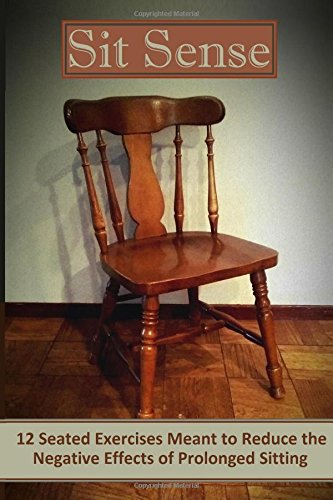Verwandte Artikel zu Sit Sense: 12 Seated Exercise Meant to Reduce the Negative...

Zu dieser ISBN ist aktuell kein Angebot verfügbar.
Alle Exemplare der Ausgabe mit dieser ISBN anzeigen:
Reseña del editor:
Prolonged sitting leads to an abnormal posture. Herein are 12 exercises meant to correct any imperfect sitting habits, while also generating a significant isometric muscular workout. This is essentially seated yoga, and it teaches you how to be mindful of how you are sitting while strengthening relevant muscles.
Reseña del editor:
So now sitting is bad for you? Apparently. Excessive sitting has been associated with depression, anxiety, stress [1] and a decreased life expectancy [2]. It has also been related to poor posture and bodily aches [3]. Dr. Anup Kanodia, physician and researcher at Ohio State University’s Wexner Medical Center, went as far as to say that “sitting is the new smoking” (LA times). These health detriments arise from a combination of the poor posture and the lack of physical activity that coincide with relaxed sitting. These seated exercises were designed to counteract the harmful effects of prolonged sitting. These low-impact, or rather "no-impact", exercises can be done by anyone, no matter how weak or strong you may be. All the exercises are isometric, which means you are training your muscle without lengthening or contracting it due to an equal force opposing the movement. For example, pushing an immovable wall or yoga. This means that while you are doing these seated exercises in the office, on the plane, or on the couch, people will not easily be able to recognize that you are actually exercising. Isometric exercise is efficient too. In fact, a research study demonstrated that isometrics significantly activate more of your muscle than any other type of muscle workout [4]. Isometrics have been shown to reduce the amplitude of tremors in the elderly [5]. Isometric exercise decreases blood pressure more efficiently than aerobic exercise and resistance training [6]. Amazingly, a scientific review by Owen et al demonstrated that isometric exercise for less than one (yes, only 1) hour per week reduces systolic blood pressure on average by about 10 mm Hg and diastolic blood pressure by 7 mm Hg [7]! This drop in blood pressure was exhibited in all ages [8]. Not only are you attenuating the mal-effects of sitting, but you are also getting a genuine workout when doing these seated exercises regardless of age or gender [5][6][7][8][9][10]. No additional Equipment is required. 1) Rebar AL, Vandelanotte C, Van Uffelen J, Short C, Duncan MJ. (2014). Associations of overall sitting time and sitting time in different contexts with depression, anxiety, and stress symptoms. Mental Health and Physical Activity. 2) Pavey TG, Geeske Peters GMEE, Brown WJ. (2012). Sitting-time and 9-year all-cause mortality in older women. British Journal of Sports Medicine. 3) Brink Y, Louw QA. (2013). A systematic review of the relationship between sitting and upper quadrant musculoskeletal pain in children and adolescents. Manual Therapy, 18(4), 281-288. 4) Babault N, Pousson M, Ballay Y, Van Hoecke J. (1985). Activation of human quadriceps femoris during isometric, concentric, and eccentric contractions. J Appl Physiol, 91(6), 2628-2634. 5) Durbaba R, Cassidy A, Budini F, Macaluso A. (2013). The effects of isometric resistance training on stretch reflex induced tremor in the knee extensor muscles. J Appl Physiol, 114, 1647-1656. 6) Carlson DJ, Dieberg G, Hess NC, Millar PJ, Smart NA. (2014). Isometric Exercise Training for Blood Pressure Management: A Systematic Review and Meta-analysis. Mayo Clinic Proceedings, 89(3), 327-334. 7) Owen A, Wiles J, Swaine I. (2010). Effect of isometric exercise on resting blood pressure: a meta analysis. Journal of Human Hypertension. 24, 796-800. 8) Baross AW, Wiles JD, Swaine IL. (2013). Double-leg isometric exercise training in older men. Open Access Journal of Sports Medicine. 2013(4), 33-40. 9) Macaluso A, De Vito G, Felici F, Nimmo MA. (2000). Electromyogram changes during sustained contraction after resistance training in women in their 3rd and 8th decades. European Journal of Applied Physiology,82(5-6), 418-424. 10) Darcus HD, Salter N. (1955). The effect of repeated muscular exertion on muscle strength. J Physiol. 129, 325-336.
„Über diesen Titel“ kann sich auf eine andere Ausgabe dieses Titels beziehen.
- VerlagBook Shed
- Erscheinungsdatum2014
- ISBN 10 0990606104
- ISBN 13 9780990606109
- EinbandTapa blanda
- Anzahl der Seiten46
(Keine Angebote verfügbar)
Buch Finden: Kaufgesuch aufgebenSie kennen Autor und Titel des Buches und finden es trotzdem nicht auf ZVAB? Dann geben Sie einen Suchauftrag auf und wir informieren Sie automatisch, sobald das Buch verfügbar ist!
Kaufgesuch aufgeben